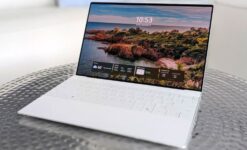
First Retail Intel Lunar Lake Laptop From Dell Impresses In Benchmarks
| Dell XPS 13 (9350): Starting At $1,399 | $1,899 As Configured The new Dell XPS 13 (9350), powered by Intel’s Core Ultra 200V platform, offers great performance and even better battery life, though we’re looking forward to testing higher-end Lunar Lake chips in future releases. |
|||

|

|
||
The laptop market and tech enthusiast circles in general have been eagerly awaiting the arrival of Intel’s new Core Ultra 200V Series of mobile platform processors, previously know by their code name Lunar Lake. From Intel’s first tease this year at Computex in Taiwan, to the company’s more recent coming out party earlier this month at IFA, there has been much anticipation of what the follow-up to Intel’s Core Ultra Meteor Lake CPUs will deliver for laptops in the run-up to the holiday shopping season.
Intel made bold claims about Lunar Lake performance, sharing multiple data points versus the new crop of stiff competition from both the Qualcomm Snapdragon X Elite and AMD Ryzen AI 300 Series. And so, to say that we were equally as eager get some quality hands-on testing time with Intel Lunar Lake retail-ready laptops, would be a monumental understatement. The good news is, we can shareu our deep dive shakedown of Dell’s new XPS 13 (9350) today, that has an Intel Core Ultra 7 258V 8-core processor under its hood driving the Windows 11 Copilot+ experience. We should underscore that we have yet to receive machines in house with Intel Core Ultra 9 288V or Core Ultra 7 267V series processors on board, to match-up with Intel’s previous performance claims, though we’re told by multiple OEMs that time frame is looking like mid October, which is right around the corner.
So in that regard, keep in mind that the performance numbers you’ll be sifting through here in our analysis, will improve as we get chance to test higher-end Lunar Lake laptop offerings, hopefully in just a few short weeks. In the meantime, let’s run down Dell’s XPS 13 (9350) specs and features, and then kick the tires and light the fires on the first Intel Lunar Lake laptop to hit our test benches…
Dell XPS 13 (9350) Specifications & Features

The laundry list of specs for this Dell XPS 13 model will not look vastly different, if you’re familiar with previous versions of this notebook. Here we’re treated to the usual, super-premium machined aluminum chassis design of current crop of XPS machines, along with either 1080p non-touch IPS InfinityEdge (super-thin bezel) displays, or an absolutely gorgeous 3K OLED touch display, along with a 512GB NVMe SSD, WiFi-7 connectivity, a pair of Thunderbolt 4 ports and a 55 Wh battery.
However, that’s where the similarities end, because on board is a completely new laptop silicon engine, powered by Intel’s Core Ultra 200V Series Lunar Lake processors, with on-package LPDDR5X memory clocked at a blistering 8533 MT/s (Mega-Transfers per second). This goes a long way to increasing memory bandwidth and reducing some latency as well, for both its CPU, GPU and NPU processors and accelerators.
From a design standpoint, it’s hard to argue with Dell’s refinements of the XPS 13 platform over the years, and we really like the machine’s zero lattice keyboard with over-sized key caps that offer a very forgiving typing experience. We do wish Dell would label the blank power button on the top right row of the keyboard in a future iteration, however. And those who are finicky about their trackpad designs will likely find the XPS’ invisible trackpad a bit striking on first glance. It takes some getting used to, in terms of feel and muscle memory, but after a couple of weeks riding the smooth lines of seemingly limitless palm rest, you should get up to speed on this deck. That said, this is a somewhat subjective area, so if this design choice is too jarring for you, then so be it.
Intel Graphics Command Center Software Experience
We’ve covered Dell’s Windows 11 software package in many reviews here at HotHardware, so we’re not going to reinvent the wheel in this review, since our coverage and analysis here is more about Intel’s Lunar Lake platform within the machine. That said, we would like to offer an update on Intel’s Graphics Command Center, which is rather well-appointed now, providing good access and control of Intel Arc Graphics features onboard the Dell XPS 13 (9350).
It’s been a while since some of you may have visited Intel’s Graphics Command Center (if ever?) but there’s a lot going on here, including adjustment for display color depth, brightness, contrast and saturation. For the former, choose BPC_10 (10-bit color depth). When you know what to look for, and have 10 bit source media, there is a tangible difference and you’ll thank us. On the Global Settings tab of the Display menu, there are Adaptive Sync controls for variable refresh rate displays, though the Dell XPS 13’s display that we tested doesn’t offer these features. The Video menu has settings for color correction, noise reduction and Film Mode detection to recover original film content as well. Finally, on the System menu, you’ll find settings for things like Panel Self refresh, which allows the display to save power by allowing it to refresh independently when the image on the display is static and doesn’t change frequently.
And now, it’s time to see how Intel’s Lunar Lake laptop platform performs onboard the newest Dell XPS 13 (9350) and how it stands up to the competition…









